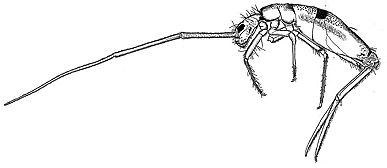 |
Class
and Order - COLLEMBOLA
(Greek, kolla= glue; embolon= tail)
Common Name: springtails
Distribution: Cosmopolitan
Description
Springtails are small arthropods closely related to insects. They are
soft-bodied, wingless and compound eyes are absent or weakly developed.
Mandibles are well developed but hidden inside head folds until pushed out
for feeding. Body length ranges from 0.2-6.0 mm. Antennae have 4-6
segments. The abdomen is six-segmented and has a specialised appendage
called a furcula on the fourth segment. The furcula is used for jumping
and gives the arthropod its common name of springtail. When the arthropod
is at rest, the furcula is folded under the body and is caught on a
specialised hook on the third segment. When the furcula is released it
rapidly moves downward and hurls the arthropod into the air. Springtails
are an extremely ancient order and are known from Devonian fossil
deposits.
Nymph
There is no metamorphic cycle of egg-larva-pupa-adult. On hatching from
the eggs, nymphs resemble miniature adults. The immature springtail nymphs
pass through several moults of the exoskeleton until they reach adult size
and maturity.
Members
Springtails.
Food
Springtails are abundant in decaying plant material and are one of the
principal litter organisms on rainforest floors. Most springtails consume
decaying plant material but some species attack fungi or feed on growing
plants.
Importance
Springtails appear to be extremely important in the biological cycles of
plant communities because they assist in the decomposition of litter. They
are generally present in immense numbers and as such they often form an
important food source for ground foraging forest birds. Sminthurus
viridis, the lucerne flea, is an important economic pest that attacks
the foliage of lucerne and clover. The commercial production of mushrooms
must ensure that infestation by springtails is controlled, otherwise
considerable damage can be done to the developing fungi. High humidity,
temperature levels and the mushroom beds are ideal for springtail
reproduction. Populations then transfer their feeding to the developing
mushrooms. Control is usually achieved by bed sterilisation or by low
toxicity insecticides such as pyrethrum.